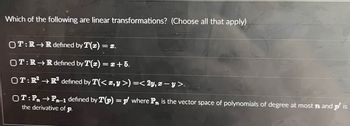
Advanced Engineering Mathematics
10th Edition
ISBN: 9780470458365
Author: Erwin Kreyszig
Publisher: Wiley, John & Sons, Incorporated
expand_more
expand_more
format_list_bulleted
Question

Transcribed Image Text:Which of the following are linear transformations? (Choose all that apply)
OT:RR defined by T(x) =
= 3.
OT:R→R defined by T(x) = x+5.
OT: R² →R² defined by T(< x,y >) =< 2y, x − y >.
OT: Pn →Pn-1 defined by T(p) = p where P is the vector space of polynomials of degree at most n and p' is
the derivative of p.
Expert Solution
arrow_forward
Step 1: We give definition of linear transformation.
(.) Linear transformation:
Let and
be two vector spaces over a same field
, then function
is called a linear transformation if,
Now we find which of the following given are linear transformations.
Step by stepSolved in 3 steps with 44 images

Knowledge Booster
Similar questions
- Let P, denote the vector space of polynomials in the variable x of degree n or less with real coefficients. Let D: P3 → P₂ be the function that sends a polynomial to its derivative. That is, D(p(x)) = p' (x) for all polynomials p(x) E P3. Is D a linear transformation? Let p(x) = a3x³ + a₂x² + ₁x + ao and q(x) = b3x³ + b₂x² + b₁x + bo be any two polynomials in P3 and c E R. a. D(p(x) + q(x)) = D(p(x)) +D(q(x)) = + Does D(p(x) + q(x)) = D(p(x)) + D(q(x)) for all p(x), q(x) E P3? choose b. D(cp(x)) = c(D(p(x))) = Does D(cp(x)) = c(D(p(x))) for all c ER and all p(x) E P3? choose c. Is D a linear transformation? choose (Enter a3 as a3, etc.) + +arrow_forwardLet Pn denote the vector space of polynomials in the variable x of degree n or less with real coefficients. Let D : P3 - P2 be the function that sends a polynomial to its derivative. That is, D(p(x)) = p' (x) for all polynomials p(x) = P3. Is D a linear transformation? Let p(x) = a³x³ + ²x² + a₁ + a₁ and q(x) = b3x³ + b₂x² + b₁x + b₁ be any two polynomials in P3 and c E R. a. D(p(x) + q(x)) = . (Enter a3 as a3, etc.) D(p(x)) + D(q(x)) = Does D(p(x) + q(x)) = D(p(x)) + D(q(x)) for all p(x), q(x) = P3? choose b. D(cp(x)) = + c(D(p(x))) = = Does D(cp(x)) = c(D(p(x))) for all CER and all p(x) = P3? choose ✪ c. Is D a linear transformation? choose ◆arrow_forwardLet denote the vector space of polynomials in the variable x of degree n or less with real coefficients. Let D: 03 → be the function that sends a polynomial to its derivative. That is, D(p(x)) = p'(x) for all polynomials p(x) E 3. Is D a linear transformation? Let p(x) = a3x³ + a₂x² + a₁x + aº and q(x) = b3x³ + b₂x² + b₁x + bo be any two polynomials in 3 and c E R. a. D(p(x) + q(x)) = D(p(x)) + D(q(x)) = Does D(p(x) + q(x)) = D(p(x)) + D(q(x)) for all p(x), q(x) = ? choose b. D(cp(x)) = c(D(p(x))) = Does D(cp(x)) = c(D(p(x))) for all c ER and all p(x) E 3? choose c. Is D a linear transformation? choose . (Enter a3 as a3, etc.)arrow_forward
arrow_back_ios
arrow_forward_ios
Recommended textbooks for you
 Advanced Engineering MathematicsAdvanced MathISBN:9780470458365Author:Erwin KreyszigPublisher:Wiley, John & Sons, Incorporated
Advanced Engineering MathematicsAdvanced MathISBN:9780470458365Author:Erwin KreyszigPublisher:Wiley, John & Sons, Incorporated Numerical Methods for EngineersAdvanced MathISBN:9780073397924Author:Steven C. Chapra Dr., Raymond P. CanalePublisher:McGraw-Hill Education
Numerical Methods for EngineersAdvanced MathISBN:9780073397924Author:Steven C. Chapra Dr., Raymond P. CanalePublisher:McGraw-Hill Education Introductory Mathematics for Engineering Applicat...Advanced MathISBN:9781118141809Author:Nathan KlingbeilPublisher:WILEY
Introductory Mathematics for Engineering Applicat...Advanced MathISBN:9781118141809Author:Nathan KlingbeilPublisher:WILEY Mathematics For Machine TechnologyAdvanced MathISBN:9781337798310Author:Peterson, John.Publisher:Cengage Learning,
Mathematics For Machine TechnologyAdvanced MathISBN:9781337798310Author:Peterson, John.Publisher:Cengage Learning,


Advanced Engineering Mathematics
Advanced Math
ISBN:9780470458365
Author:Erwin Kreyszig
Publisher:Wiley, John & Sons, Incorporated

Numerical Methods for Engineers
Advanced Math
ISBN:9780073397924
Author:Steven C. Chapra Dr., Raymond P. Canale
Publisher:McGraw-Hill Education

Introductory Mathematics for Engineering Applicat...
Advanced Math
ISBN:9781118141809
Author:Nathan Klingbeil
Publisher:WILEY

Mathematics For Machine Technology
Advanced Math
ISBN:9781337798310
Author:Peterson, John.
Publisher:Cengage Learning,

